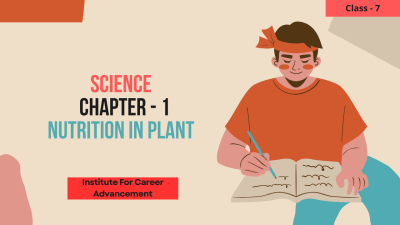| Short description |
"Nutrition in Plants" for Class 7 typically covers how plants make their food through photosynthesis. It includes concepts like the parts of a plant involved in this process (leaves, chlorophyll), what plants need for photosynthesis (water, sunlight, carbon dioxide), and how they transport water and nutrients through their roots and stems. This topic also discusses different types of plants based on their mode of nutrition, such as autotrophs and heterotrophs.
ক্লাস 7 এর জন্য "উদ্ভিদের পুষ্টি" সাধারণত সালোকসংশ্লেষণের মাধ্যমে কীভাবে উদ্ভিদ তাদের খাদ্য তৈরি করে তা কভার করে। এটিতে এই প্রক্রিয়ার সাথে জড়িত একটি উদ্ভিদের অংশ (পাতা, ক্লোরোফিল), সালোকসংশ্লেষণের জন্য উদ্ভিদের কী প্রয়োজন (জল, সূর্যালোক, কার্বন ডাই অক্সাইড) এবং কীভাবে তারা তাদের শিকড় এবং কান্ডের মাধ্যমে জল এবং পুষ্টি পরিবহন করে তার মত ধারণাগুলি অন্তর্ভুক্ত করে। এই বিষয়টিতে অটোট্রফ এবং হেটেরোট্রফের মতো তাদের পুষ্টির পদ্ধতির উপর ভিত্তি করে বিভিন্ন ধরণের উদ্ভিদ নিয়েও আলোচনা করা হয়েছে। |
|
|
| Outcomes |
- Here are the expected outcomes: Knowledge and Understanding: Students should demonstrate a clear understanding of the process of photosynthesis, including its inputs (carbon dioxide, water, sunlight) and outputs (glucose, oxygen). They should be able to explain the role of chlorophyll in photosynthesis and describe the structure and function of chloroplasts in plant cells. Conceptual Understanding: Students should grasp the difference between autotrophic and heterotrophic nutrition and be able to identify examples of each. They should understand how plants absorb water and minerals through roots and transport these substances through the xylem and phloem tissues. Application of Knowledge: Students should be able to apply their knowledge of plant nutrition to explain the nutritional requirements of different types of plants (e.g., terrestrial vs. aquatic plants, parasitic plants, insectivorous plants). They should demonstrate an understanding of how environmental factors such as light intensity, carbon dioxide levels, and temperature affect the rate of photosynthesis. Critical Thinking and Analysis: Students should develop critical thinking skills by analyzing experimental data related to plant nutrition, interpreting results, and drawing conclusions based on evidence. They should be able to evaluate the impact of human activities on plant nutrition and the environment, such as deforestation, pollution, and climate change.
- এখানে প্রত্যাশিত ফলাফল আছে: জ্ঞান এবং বোঝা: শিক্ষার্থীদের সালোকসংশ্লেষণের প্রক্রিয়া সম্পর্কে স্পষ্ট বোঝার প্রদর্শন করা উচিত, এর ইনপুট (কার্বন ডাই অক্সাইড, জল, সূর্যালোক) এবং আউটপুট (গ্লুকোজ, অক্সিজেন) সহ। তাদের সালোকসংশ্লেষণে ক্লোরোফিলের ভূমিকা ব্যাখ্যা করতে এবং উদ্ভিদ কোষে ক্লোরোপ্লাস্টের গঠন ও কার্যকারিতা বর্ণনা করতে সক্ষম হওয়া উচিত। ধারণাগত বোঝাপড়া: শিক্ষার্থীদের অটোট্রফিক এবং হেটেরোট্রফিক পুষ্টির মধ্যে পার্থক্য উপলব্ধি করা উচিত এবং প্রতিটির উদাহরণ সনাক্ত করতে সক্ষম হওয়া উচিত। তাদের বোঝা উচিত গাছপালা কীভাবে শিকড়ের মাধ্যমে জল এবং খনিজ শোষণ করে এবং জাইলেম এবং ফ্লোয়েম টিস্যুর মাধ্যমে এই পদার্থগুলি পরিবহন করে। জ্ঞানের প্রয়োগ: শিক্ষার্থীদের বিভিন্ন ধরনের উদ্ভিদের (যেমন, স্থলজ বনাম জলজ উদ্ভিদ, পরজীবী উদ্ভিদ, কীটনাশক উদ্ভিদ) পুষ্টির প্রয়োজনীয়তা ব্যাখ্যা করার জন্য উদ্ভিদের পুষ্টি সম্পর্কে তাদের জ্ঞান প্রয়োগ করতে সক্ষম হওয়া উচিত। আলোর তীব্রতা, কার্বন ডাই অক্সাইডের মাত্রা এবং তাপমাত্রার মতো পরিবেশগত কারণগুলি কীভাবে সালোকসংশ্লেষণের হারকে প্রভাবিত করে সে সম্পর্কে তাদের বোঝার প্রদর্শন করা উচিত। সমালোচনামূলক চিন্তাভাবনা এবং বিশ্লেষণ: শিক্ষার্থীদের উচিত উদ্ভিদের পুষ্টি সম্পর্কিত পরীক্ষামূলক তথ্য বিশ্লেষণ করে, ফলাফলের ব্যাখ্যা করা এবং প্রমাণের ভিত্তিতে উপসংহার আঁকার মাধ্যমে সমালোচনামূলক চিন্তার দক্ষতা বিকাশ করা। তারা গাছপালা পুষ্টি এবং পরিবেশের উপর মানুষের কার্যকলাপের প্রভাব মূল্যায়ন করতে সক্ষম হওয়া উচিত, যেমন বন উজাড়, দূষণ এবং জলবায়ু পরিবর্তন।
|
|
|
| Requirements |
- Learning about plant nutrition helps students understand the internal processes of plants, including how they absorb water and minerals, transport nutrients, and utilize light energy.
- উদ্ভিদের পুষ্টি সম্পর্কে শেখা শিক্ষার্থীদের উদ্ভিদের অভ্যন্তরীণ প্রক্রিয়াগুলি বুঝতে সাহায্য করে, যার মধ্যে তারা কীভাবে জল এবং খনিজগুলি শোষণ করে, পুষ্টি পরিবহন করে এবং হালকা শক্তি ব্যবহার করে।
|
|
|


 0
0 